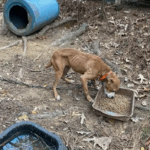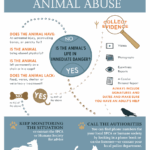In the vast digital landscape, where information is shared at lightning speed, the proliferation of graphic animal cruelty posts has become an unsettling reality. While the intention behind sharing such posts usually stems from a desire to foster awareness about animal suffering, it is essential to delve into why we should reconsider this approach. Just as one wouldn’t attend a fine art gallery to gaze upon a grotesque spectacle of destruction, the sharing of disturbing images of animal cruelty often serves more harm than good. This article elucidates the myriad reasons why abstaining from sharing these graphic depictions is not only prudent but beneficial for both the cause of animal rights and the psychological well-being of individuals.
First and foremost, let’s consider the psychological impact associated with exposure to graphic content. Imagine your mind as a fragile butterfly, fluttering through a garden teeming with vibrantly colored flowers. Each shared image of brutal animal treatment is akin to a sudden tempest, disrupting the tranquility of that garden. Frequent exposure to such distressing visuals can lead to compassion fatigue—a phenomenon wherein individuals become desensitized to suffering. This numbing effect risks transforming empathy into apathy, a dangerous outcome that could ultimately jeopardize the very campaign against animal cruelty.
Furthermore, it is crucial to recognize that the visceral reactions elicited by these posts can be counterproductive. While the intent is to incite outrage and galvanize action, the reality often reflects a different narrative. Like a double-edged sword, graphic images can alienate potential allies who might otherwise rally behind the cause. Instead of fostering a constructive dialogue about animal welfare, these posts can induce despair, hopelessness, and withdrawal. Stimulating individuals to become active participants in the fight against animal cruelty requires engendering hope—not dread.
Moreover, sharing graphic posts can lead to an oversimplification of complex issues surrounding animal rights. The stark depiction of cruelty often obscures the systemic and nuanced nature of the problem. Animal abuse is not merely an outcome of individual malice but is deeply intertwined with societal values, economic structures, and legal frameworks. Thus, rather than illuminating the breadth of these issues, graphic imagery can distort perceptions, positioning animal cruelty as an isolated incident rather than a societal malaise that necessitates comprehensive reform.
Additionally, consider the ethical implications of sharing such content. When we disseminate graphic images of suffering, we run the risk of commodifying pain—transforming the plight of animals into mere fodder for clicks and shares. It’s imperative to reflect on the sanctity of the beings depicted. Each animal’s suffering is not a prop for social media success, but a profound tragedy warranting respect and dignity. Instead of exploiting their pain for attention, advocates must seek to instead empower the voices of the voiceless and illuminate their stories with dignity.
Assuredly, there exist more constructive alternatives to galvanize action without resorting to graphic imagery. Educational posts that inform readers about animal welfare laws, need for rescue efforts, and ethical treatment can serve as powerful tools in advocacy. Infographics elucidating statistics or highlighting success stories in animal rescue and rehabilitation can foster a sense of community and commitment among supporters. Storytelling, too, becomes a paramount means of connection. Sharing narratives of resilience and recovery encourages empathy and motivates action without the burdensome weight of graphic content.
Moreover, engaging local communities through events, workshops, or campaigns focused on animal welfare offers a tangible route to effecting change. This approach not only cultivates informed advocates but also fosters an emotional connection to the cause, positively influencing attitudes toward animal rights. Social media can thus serve as a synergistic platform, promoting constructive dialogues and community engagement rather than becoming a dark abyss filled with suffering imagery.
In closing, the impulse to share graphic posts of animal cruelty may arise from a well-meaning desire to effect positive change. However, it is imperative to discern the broader implications of this practice. These images can unwittingly desensitize, alienate, and exploit—not to mention detract from the more pressing systemic issues surrounding animal welfare. Like a garden that thrives under sunlight and care, a movement for animal rights flourishes when nurtured with compassion, hope, and respect. By choosing to share knowledge and articulate stories that inspire, we can create a landscape where advocacy for our animal companions flourishes free from the shadows of graphic despair. Embrace the light of informed action, and let us together illuminate a path toward a more compassionate world.





